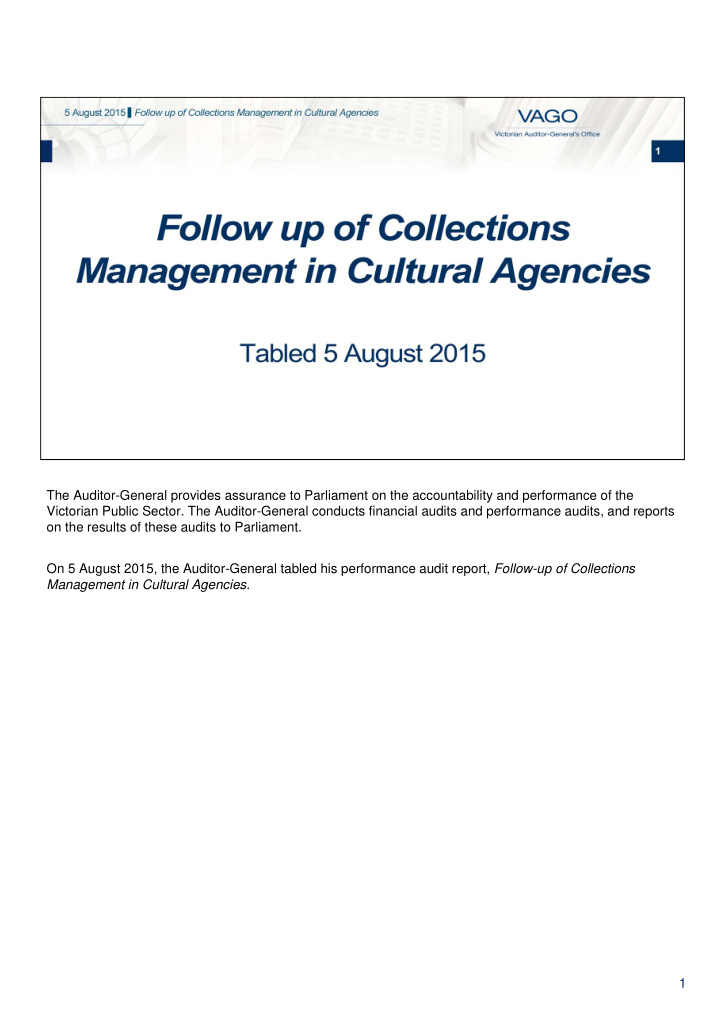



The Auditor-General provides assurance to Parliament on the accountability and performance of the Victorian Public Sector. The Auditor-General conducts financial audits and performance audits, and reports on the results of these audits to Parliament. On 5 August 2015, the Auditor-General tabled his performance audit report, Follow-up of Collections Management in Cultural Agencies. 1
This report is part of the second phase of VAGO’s follow-up program. The first phase involved all agencies audited in 2012–13 self-attesting to their progress in implementing recommendations. In this second phase we selected three audits, based on an assessment of risk and materiality, for detailed follow-up, to verify the information the agencies reported. The aim was to provide further information to Parliament and the community about improvements that agencies may have made since the initial audit. We assessed three things: • First, that agencies had acted to implement the recommendations that they’d agreed to. • Second, that the actions they undertook addressed the underlying issues that led to the recommendations being made. • And third, that agency audit committees were assessing the actions for impact, as they are required to do. 2
Victoria's state collections have natural history, scientific, historical, artistic and cultural significance and economic value, and require effective management to make them available to current and future generations. As at March 2015, there were around 38.7 million individual collection items valued at over $5 billion. In October 2012, VAGO tabled an audit of Collections Management in Cultural Agencies . It examined whether state collections were adequately managed, including whether agencies holding key collections had adequate collection management policies, systems and practices and could demonstrate performance against relevant statutory obligations. The 2012 audit made four recommendations covering the accessibility of collections, collections management and Arts Victoria’s leadership role in addressing systemic issues with the management of state collections. 3
This follow-up audit examined the progress that agencies have made in implementing the recommendations from the 2012 audit. The audit involved the four agencies from the original audit: Creative Victoria (then Arts Victoria), the National Gallery of Victoria (NGV), Museum Victoria and the Public Record Office Victoria (PROV). We found that the agencies have all demonstrated progress towards addressing the recommendations. However, the size and diversity of collections, and available resources mean that the recommendations have not been fully completed. The nature of the collections means that addressing the recommendations will likely take considerable time. 4
Creative Victoria has taken steps to advocate for the necessary resources to increase storage capacity, consistent with our 2012 recommendation. It has secured funding to address short-term storage issues and continued to pursue long-term collection storage solutions. Creative Victoria has taken steps to address the scope and rigour of performance benchmarking and measurement. However it has not acted on the recommendation to coordinate a plan to address legacy data issues. This is a gap that needs to be addressed. 5
In 2012, VAGO found that a low proportion of collections were ever on public display. While agencies had made progress in increasing access to their collections through digitisation, activity to digitise collections had not been guided by adequate strategies. Agencies have developed strategies to guide digitisation activity, have implemented oversight arrangements to regularly monitor and report on the progress of digitisation activity, and are tracking how much of collections are accessible online. Both NGV and Museum Victoria have taken action to address VAGO’s recommendation to analyse the impact of blockbuster exhibitions on visitor numbers. The agencies have undertaken specific audience research to understand what motivates visitors, to better support planning for both blockbuster and permanent exhibitions. Conservation of collections is a key part of accessibility. In 2012, VAGO found that there was a lack of comprehensive condition information on collections. The agencies have all acted to address this recommendation to varying extents. They face unique challenges in relation to the size, diversity and the resources available to enable this to occur for their entire collections. Museum Victoria, NGV and PROV have modified processes to improve information about the condition of their collections. In addition, these agencies are working toward improving collection stocktakes and processes for removing items from their collection. This should provide them with information about the care and management requirements of their collections, and also alleviate storage constraints. 6
Audit committees play a key role in the follow-up process. Under the Minister for Finance’s standing directions, audit committees are required to monitor the implementation of recommendations. This includes reviewing the impact of actions undertaken. While all audit committees, boards and council of trustees monitored the progress of implementation, none had frameworks in place to review the impact of the actions taken, and none were consistently reviewing this impact. As a consequence, audit committees were not in a position to adequately hold management to account, and nor were they in a position to assure themselves that actions taken in response to recommendations were effective in addressing the underlying issues. 7
To recap the key messages from the audit: • Agencies have progressed in addressing recommendations but a coordinated plan for addressing legacy data issues is still required. • Agencies need to continue their efforts in obtaining condition information and to develop frameworks to support audit committees to assess the impact of their actions. 8
Overall, it is clear that agencies are generally taking recommendations seriously and acting to implement them. However, there remains a need for audit committees to improve their oversight and assure themselves that actions are having the desired impact. 9
All our reports are available on our website. If you have any questions about this or other reports, or if you have anything else you would like to discuss with us including ideas for future audit topics, please call us on 03 8601 7000 or contact us via our website. 10
Recommend
More recommend